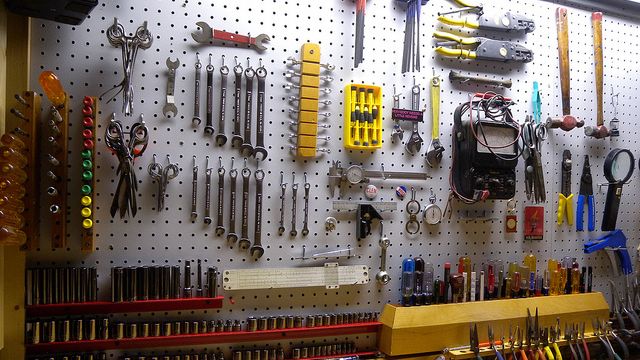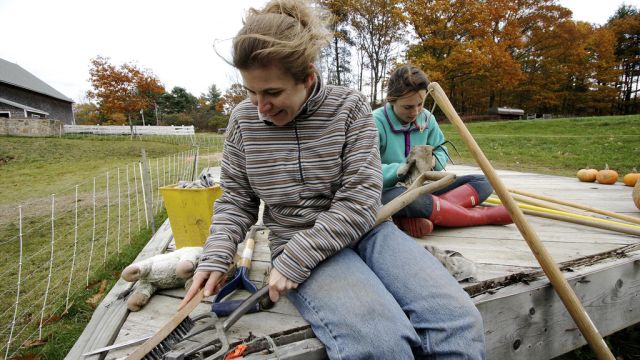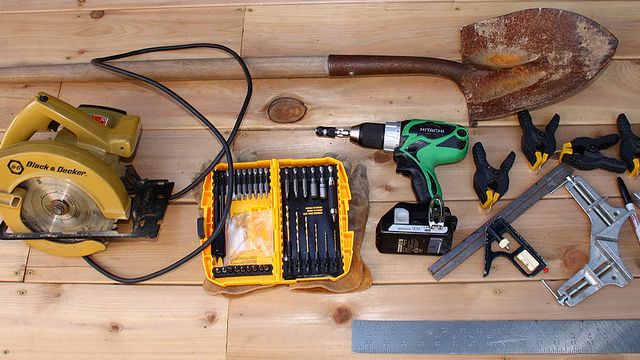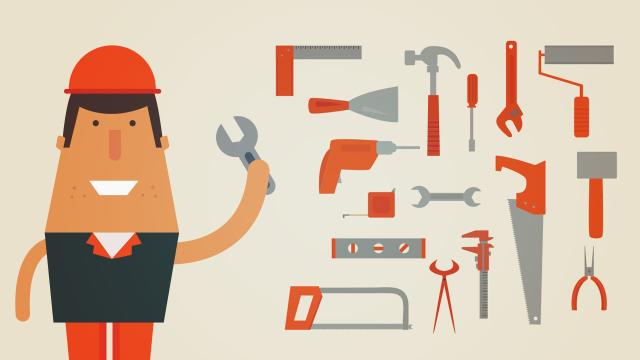Good tools are an expensive investment, but if you take good care of them, they will last a lifetime of renovations. Keeping your tools properly stored, cleaned and maintained will save you time and money and make your DIY endeavours that much more rewarding.
Photo by Rooster Stock (Shutterstock), mtneer_man, Chewonki Semester School and ArturoYee.
We’re talking about hand tools, power tools and garden tools in this article, but much of the same advice applies if your tools of choice are kitchen knives, crafting tools or anything else. Store them well, keep them clean and well-maintained, and you won’t regret it.
Store Your Tools Properly

You have to work with the space you have. Maybe you hang them on pegboards; maybe you store them in boxes, bags, or chests; maybe you keep them in drawers or on shelves in your garage. Whatever works for you is fine.
Pegboards make a great storage system for tools. They let you see all your tools at a glance and they can make use of wall space in an efficient way. If you don’t have enough wall space, you can still take advantage of pegboards by building a hinged system, a rolling pegboard, or even a portable pegboard storage system .
Toolboxes also make for good tool storage, offering the huge advantage of portability. While some people opt to store all their tools in toolboxes, for most of us the toolbox is a way of carrying around your most-used tools while leaving the bulk safely stored elsewhere. You can build a well-equipped toolbox for every level of DIY needs.
Rust is public enemy number one when it comes to tools. To avoid rust when storing your tools:
- Keep your tools in a dry place. It seems obvious, but garages and basements and other enclosed spaces can have humidity issues, especially if they are not heated or air-conditioned. If you keep your tools in a location like this, especially if you keep them out on shelves or pegboards, consider investing in a dehumidifier to keep the dampness level down. They’re not terribly expensive, especially compared to your investment in your tools, and most let you set a humidity level so the dehumidifier turns on only when it needs to.
- Hang your garden tools. Even if you keep your garden tools inside the garage or your shed, hang them so that they don’t rest on the floor. Moisture can easily creep up from concrete floors.
- Store power tools in their original cases. Unless you have a climate-controlled workshop, your best bet for storing power tools is the hard plastic cases they come with. Not only are they kept safe from humidity, they’re better-protected in general.
- Use silica gel packs or rust collector. The silica gel packs that come in lots of packaging are great at keeping moisture at bay. Toss them in drawers or toolboxes and they can help keep rust away. You can also buy rust inhibitors for the same purpose, and even anti-rust liners for drawers and shelves.
Clean Your Tools After Every Use

Cleaning your tools may be the last thing you want to do after a day of work, but it’s essential for keeping your tools in good shape. It only takes a few seconds per tool unless you’ve got something really nasty on your hands. It’s well worth the time spent doing a little cleaning to save the time spent repairing a tool (or the money spent replacing it) later.
Cleaning your tools doesn’t have to be difficult at all if you’re prepared:
- Hand tools: You can clean most hand tools by simply wiping them down with a rag. If they’re dirty, don’t be afraid to give them a good wash with soap and water. Just dry them well afterward. Spritz metal with a light coat of WD-40 and wipe with a clean rag (you really just want to leave a light film on them to help keep the rust away). Wipe wooden handles with a rag dampened with a little linseed oil.
- Garden tools: You can clean garden tools in much the same way as hand tools. Wash them if necessary, dry, and oil them up. For a quick way to clean, some people like to keep a bucket of sand mixed with a bit of oil. Just stab the tools into the bucket a few times to clean and oil them at the same time. Some folks use motor oil in their sand, but even the little bit of motor oil left on the tools can harm your soil, so for garden tools, stick with linseed oil. You’ll also want to rub down wooden handles with a bit of linseed oil.
- Power tools: Power tools are a little trickier to clean. First, make sure the tool is unplugged before you clean it. Next, you’ll want to get all the dust off. An air compressor can be really useful for that. Wipe down the surface of the tool and then lubricate any moving parts. Machine oil is a fine choice for this, but you should also check the manual that came with the tool to see if it has specific recommendations.
While you’re at it, don’t forget that your toolboxes, belts, and bags will need some care as well. Clean out your toolboxes every once in a while by emptying them and wiping them down. If you have leather belts and bags, you’ll want to condition the leather once in a while. For bags and belts not made of leather, a quick wash should do the trick.
Inspect (And Repair) Your Tools Every Time You Use Them

We’re going to assume you use your tools safely. You wear goggles and gloves when you should and you follow the safety protocols recommended for your power tools. Beyond that, taking the time to inspect your tools every time you use them is one of the most important things you can do to ensure not only your safety while using them, but the longevity of your tools as well.
Look for the following:
- Loose, cracked or splintered handles. If a wooden handle is damaged, it is prone to breaking during use, which can cause injury to you or others. If a handle is not splintered too badly, you can probably sand it down just fine. Sand against the grain first if the handle is really rough and then sand with the grain until it’s smooth enough you can run your hand along it without feeling any chips or splinters. Finish off with a coating of linseed oil. However, if the handle is cracked or heavily splintered, you’ll need to replace it.
- Mushroomed heads on tools like chisels and wedges. A mushroomed head is exactly what it sounds like: a striking edge that should be sharp but has become malformed through use. If you use a tool in this condition, the head can shatter on impact. Fortunately, you can solve this problem by keeping your tools sharpened. Sharpen them whenever you notice a problem, but also plan to sharpen them every six months or so as a habit.
- Corrosion and rust. Depending on the level of corrosion or rust, the tool may be unsafe to use. Try removing the rust yourself or just replacing the tool. Removing rust from tools is relatively easy if the damage isn’t too great.
- Cracked housing on power tools. If a power tool has anything more than a simple hairline crack on the housing, don’t use it. Unless you have the expertise to repair it, you’ll need to get it repaired by a professional.
- Power tools that don’t start easily. If your tool needs a couple of tries to get going or a little “push” to get the blade spinning, don’t use it. Take the time to clean and lubricate it and if that doesn’t solve the problem, have it repaired. There are some fixes you can take on yourself, such as replacing a belt on a sander or maybe fitting in a new switch or power cord. But if you’re not 100 per cent sure you’re up to the repair, take it to a pro.
- Frayed insulation or exposed wires. Obviously, these are electrical hazards. While some electrical tape might take care of a small problem temporarily, it’s best to have the tool repaired before using it.
Taking care of your tools does require a bit of a commitment, but you ask so much of them it seems a small price to pay. Especially when a well-cared-for tool can reward you with so much DIY goodness.

Comments
6 responses to “How To Take Care Of Your Tools”
Now replace tools with genitals and read the article again
no sanding required…
This is incorrect in Australia. Repairs to any 240V electrical items must be done by a licensed electrician (unlike the USA).
Otherwise, a pretty good article. Good advice about not using motor oil on garden tools, especially if you are interested in organic gardening.
I was stupid and sliced my cord by accident first go with my circular hand saw. I just taped it up a bit. All good.
One time I had to replace the plug on an ice cream maker cause it was old and the plastic had cracked, got a new three pronged plug, three wires….good as new
EDIT: I didn’t die or get shocked yet either, but safety first…pretty hard to stuff up safety when it is only three wires and power on or off
Yes, I agree in principle. At my work I’ve seen some pretty shoddy electricians, working with little care and attention to detail, producing work that a rank amateur could do better.
It’s really not that hard to screw in some terminals to replace a electrical cord. With modern earth leakage devices you are fairly safe even if you screw it up.
The point was more that the cut and paste approach from the US website can produce some both illegal and unsafe advise for the less cautious and for Australian regulations.
Still hasn’t been corrected by the way.
PS I’m jealous that you have an ice cream maker.
does any one know if the peg board as pictured above works well??
Mine are all in tool boxes and drawers and tubs. No order at all